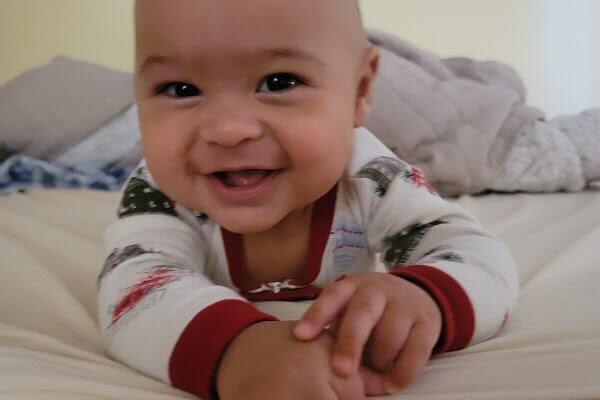For first-time Moms, breastfeeding your new baby can seem like a daunting task. We love this March of Dimes picture guide to breastfeeding. The pictures might be outdated (hello, 80’s hair!), but the information is simple and easy-to-follow.
Do you have any of your own tips? Leave them in the comments below!
Article Courtesy of The March of Dimes
If you’re like many new moms you have some concerns about breastfeeding. You know that breastmilk is the perfect food for your baby, and that it protects against illness and helps baby’s brain develop. But you also might be thinking, “Can I do it?” and “Will my baby get enough to eat?”
With some guidance, planning, patience and practice, you and your baby can breastfeed successfully. We visited two families at the hospital on baby’s second day of breastfeeding. We hope the highlights of our visit will help you get breastfeeding off to a good start.
STEP 1. Hey, When Do We Eat?
You and baby will find feeding easier if baby is interested but not overly hungry. Begin the feeding before your baby is crying. Look for early feeding cues, like this alert face and open mouth. Tongue and hand movements are also signs that baby is ready to eat.
STEP 2. Help for Sleepyheads!
Some babies will be sleepy the first several days after birth and need a little coaxing to feed. To get baby ready, Dad can undress him down to his diaper and hold baby in an upright position (a burping position). By gently massaging and walking his fingers up baby’s back and talking softly, he will help baby become more alert and interested in eating. If baby’s skin feels too cool, you can throw a light blanket over his back.
STEP 3. What About Mom?
Gather the things you’ll need to be comfortable. Take a few slow breaths. Sip some water and keep it within reach. There is no one best position for breastfeeding. You can be seated in a chair or on a sofa. You can sit or lie in bed. Use cushions, pillows, a nursing stool—whatever you need to support your back and feet. Your goal is to be able to support your baby without straining your back, neck, arms or shoulders.
STEP 4. Get Baby in Position
Once you’ve made yourself comfortable, position baby. Here our lactation consultant helps Mom make her baby feel secure and supported. A pillow helps place the baby at a good height so neither you nor baby have to strain. Your baby needs to be close to your body to feed easily. Support her body from her head to her bottom. Your baby should be looking straight ahead at your breast with her head, back and bottom in one line. This mom is supporting her breast with her outside hand and supporting baby’s body with her opposite arm.
Step 4b. With Baby by Your Side
This mom supports her baby’s shoulders and head with her outside hand. (This is called the “football” hold.) She supports her breast with the opposite hand. To support your breast correctly, have four fingers resting on your rib cage and your thumb resting lightly on top of your breast, back from the areola (the dark part of the breast that surrounds the nipple). In the first few weeks it helps baby if you support your breast for the whole feeding. Later on do what is comfortable for both of you.
STEP 5. Nose to Nipple
Place baby so that when his mouth is closed his nose is level with your nipple. When baby opens wide and you move him forward, he will be well-positioned on your breast. His gums will be on the areola, centered around the nipple. As he feeds, this will feel comfortable to you and satisfying to baby.
STEP 6. Say Ahhh!
Wait until baby opens wide (like a yawn) then bring the baby forward to your breast. With your supporting arm, move the baby’s head and body to the breast. Think and do: baby to breast. Be patient. It does take practice. The latch-on may be uncomfortable for a moment or two. Continued breastfeeding should not hurt. If it does, most likely the positioning is not right. Gently break the suction by using your finger to release the nipple. Take a minute for a few calming breaths. Then try again. This is a good time to ask for help.
STEP 7. Success! What You See and Feel
When baby is positioned correctly, she is tucked in close to the breast with her mouth open wide. Her chin is right up against the lower part of the breast. Baby’s nose is near the breast but nostrils are clear and baby can breathe well. Her lips are flanged (opened and flattened outward) and she has a good mouthful of breast. At first, some moms notice the feeling of the nipple being drawn back into baby’s mouth at the start of the feeding. You might also feel a mild to strong tingling sensation in your breast. This is the let-down reflex.
STEP 8. Dad’s in the Picture
Dad’s role in breastfeeding is very important. When Dad has a positive attitude it is easier for Mom to begin and continue breastfeeding. Dads-to-be and new dads can learn about breastfeeding along with Mom. And dads have their own ways to nurture and play with baby—cuddling, changing, bathing, burping and soothing. Babies love to snuggle against Dad’s warm chest.
Keep Working Together
When baby latches on, he will take a few quick sucks and then begin to suck a bit more slowly, deeply and rhythmically. He will pause from time to time and then continue. The pauses will get longer as the feeding continues until it is complete.
Your baby may want to nurse on both breasts each feeding or only on one. After baby finishes on one side, give him a few minutes to rest. Then always offer the second side but keep in mind that baby may be full.
Babies have different patterns. But all newborns need to be nursed often. In general, you’ll need to breastfeed between 9 and 12 times a day for the first couple of weeks.
Try to get baby interested in feeding every couple of hours during the day and evening. You don’t need to wake your baby unless he sleeps longer than four or five hours, your breasts are uncomfortably full or your baby’s health care provider tells you to do so.
Is Baby Getting Enough?
You’ll know your baby is getting enough to eat if by the time your baby is a week old he has:
* At least six or more wet diapers each day (urine should be pale yellow)
* Three or more bowel movements each day (stool will be soft, yellow and seedy-looking)
* Steady weight gain—most babies are back to their birth weight in about a week and gain 4–8 ounces per week for the next few months
* Periods of contentment for an hour or two after most feedings
* If you think your baby is not getting enough to eat, call your health care provider right away.
A step-by-step picture guide to breastfeeding your new baby.



